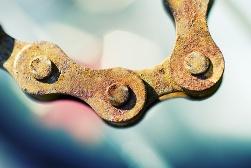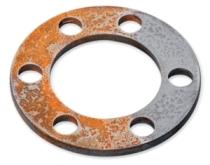Categories: Featured Articles » Sharing experience
Number of views: 25484
Comments on the article: 1
How to remove rust
 It is hardly worthwhile to talk in detail about the enormous damage caused by metal corrosion. This is common knowledge. Recall only one (also well-known) figure: approximately a tenth of the metal mined per year is spent to cover the irrevocable corrosion loss.
It is hardly worthwhile to talk in detail about the enormous damage caused by metal corrosion. This is common knowledge. Recall only one (also well-known) figure: approximately a tenth of the metal mined per year is spent to cover the irrevocable corrosion loss.
Summarizing the losses caused by corrosion damage, it is impossible to discount the premature failure of machines, parts, metal structures, and the costs of all kinds of protective measures: the development, production and application of corrosion inhibitors, galvanic and paint coatings.
The last of the listed ways to protect against corrosion the most massive. Varnishes and paints protect cars and pipelines, bridges and tanks, ships and building structures from the damaging effects of the environment. But sooner or later, red traces of rust still appear on the metal surface. Hundreds of tons of metal are being sprayed, the strength and reliability of structures are falling, and their appearance is hopelessly deteriorating.
 Corrosion Product - This is a well-known rust, a complex mixture of iron oxide compounds: hematite, ghostite, lepidocrocite, magnetite. Rust covers the metal surface with a continuous porous layer with a thickness of a few microns to millimeters.
Corrosion Product - This is a well-known rust, a complex mixture of iron oxide compounds: hematite, ghostite, lepidocrocite, magnetite. Rust covers the metal surface with a continuous porous layer with a thickness of a few microns to millimeters.
Before painting the rusted surface again, this layer must be removed, otherwise the varnish or paint will not hold. This is a very laborious and expensive process. Rust removal costs average half the total cost of painting.
Various rust methods are mainly used to remove rust before painting.: manual brushing, sandblasting and shot blasting. However, in this case, only loose layers of rust can be removed, no matter how thorough the machining, a thin corrosion film still remains on the metal surface. You can not paint on it.
If dissolve rust with chemicals (and they do so often), the iron oxides are completely removed, but at the same time the main metal of the structure begins to be etched, and sometimes, and not for the better, its mechanical properties change. In a word, cleaning rust is a complicated and not yet resolved problem. But even if the surface can be completely cleaned, the difficulties do not end there.
The metal must be primed immediately, otherwise in the rain, with dew drops, it’s just that in humid air it will be covered with a red coating for an hour or two, and then it will be necessary to start all over again.
 Rust itself - porous and brittle - cannot protect the metal from moisture. But if loose surface layer impregnate with a special compound, which reacts with corrosion products, forms persistent insoluble compounds, blocks further oxidation of iron, then rust will become an insurmountable anti-corrosion barrier. Such rust improving compounds, allowing the use of corrosion products against corrosion, are called rust converters.
Rust itself - porous and brittle - cannot protect the metal from moisture. But if loose surface layer impregnate with a special compound, which reacts with corrosion products, forms persistent insoluble compounds, blocks further oxidation of iron, then rust will become an insurmountable anti-corrosion barrier. Such rust improving compounds, allowing the use of corrosion products against corrosion, are called rust converters.
Physico-chemical mechanisms of corrosion failure can be very different. They depend on the environment and the conditions in which the metal structure is located, on the composition of the metal, mechanical load and many other factors. therefore rust converters in composition are far from the same. But usually they are prepared on the basis of phosphoric acid. It forms insoluble phosphates with iron oxides, which cement the protective film and isolate the metal from moisture. In addition, the phosphate layer serves as a good primer for subsequent painting.
In addition to phosphoric acid, the composition of the converters includes many other substances: corrosion inhibitors (for example, urea), wetting agents, degreasing surfactants, tanning agents, synthetic resins, inert fillers, pigments.
What to do if it does not work to remove rust? You can donate unnecessary and rusty metal for scrap and get paid for it.
Scrap metal is a raw material obtained in the production of metal (forging, stamping or other mechanical processing). Various parts of machine tools, machines and mechanisms, metal cases and constructions, metal utensils, and old household appliances that have become unusable, also fall into disrepair.
For anyone who wants to profitably get rid of useless metal structures and metal waste, you can use the services of one of the specialized organizations that carry out the reception of scrap metal. In such organizations, you can also order dismantling of metal structures, cutting and removal of metal.
Mikhail Barsukov
See also at bgv.electricianexp.com
:
